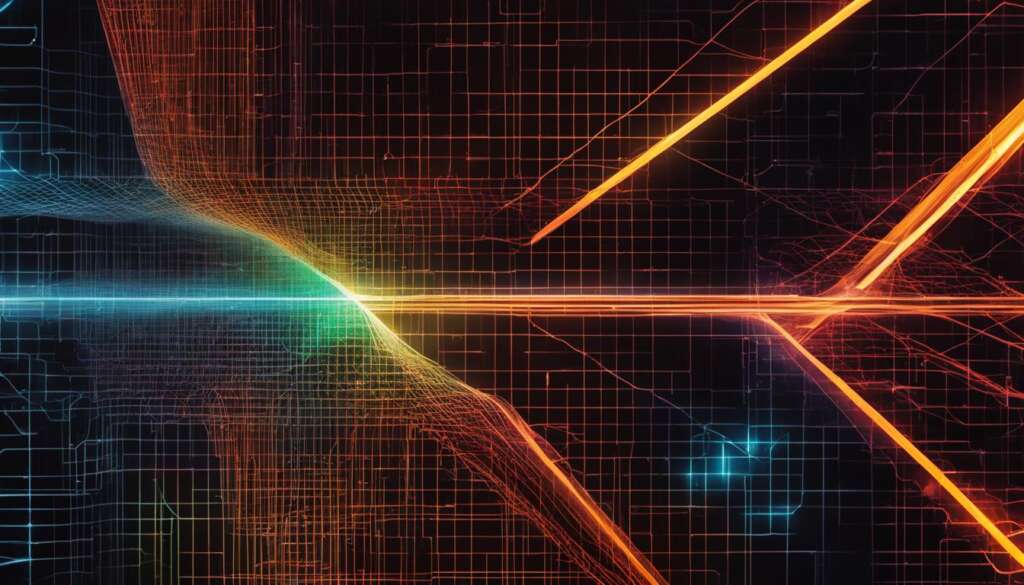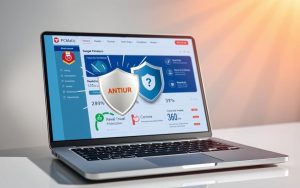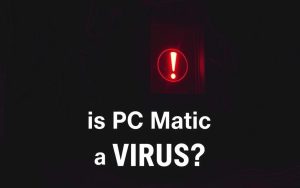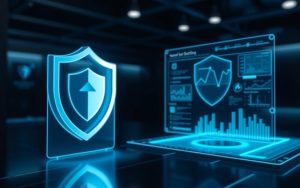Table of Contents
Welcome to our article series on cybersecurity in the energy sector. In this first section, we will explore the importance of protecting the energy grid and ensuring its resilience. Cyber threats pose significant risks to our energy infrastructure, making it essential to implement robust risk management, threat detection, vulnerability assessment, and incident response measures.
With the increasing dependency on digital technologies, the energy grid faces numerous cyber threats that can compromise its security and stability. By prioritizing cybersecurity, we can safeguard the energy grid and maintain energy security.
The Vulnerabilities in the U.S. Electricity Grid
The U.S. electricity grid, comprising interconnected transmission grids, is a critical component of the nation’s infrastructure. However, it faces vulnerabilities that could be exploited by threat actors. One key area of concern is the grid distribution systems, responsible for delivering electricity from the transmission systems to consumers. These systems have become more vulnerable due to their operational technology, which allows remote access and connections to business networks. This opens a potential pathway for cyberattacks, which could disrupt the grid’s operations.
Nation-states and criminal groups are among the threat actors that pose significant cyber threats to the U.S. electricity grid. Their motivations range from political and economic to ideological, and their capabilities continue to evolve. It is essential to address these vulnerabilities in order to safeguard the energy infrastructure and ensure the reliable delivery of electricity to consumers.
To mitigate these risks, it is crucial to have a comprehensive understanding of the vulnerabilities in the grid distribution systems and develop robust cybersecurity measures to protect against potential attacks. By implementing effective risk management strategies, conducting thorough vulnerability assessments, and establishing efficient threat detection mechanisms, the U.S. electricity grid can strengthen its resilience against cyber threats.
Vulnerabilities in the U.S. Electricity Grid
| Vulnerability | Description | Impact |
|---|---|---|
| Remote access capabilities | The operational technology used in grid distribution systems allows remote access, making them susceptible to unauthorized intrusion. | Potential disruption of grid operations, leading to power outages and service disruptions. |
| Limited cybersecurity measures | The grid distribution systems may lack comprehensive cybersecurity measures, making them more susceptible to cyberattacks. | Increased risk of successful cyber intrusions and potential compromise of the grid’s integrity and reliability. |
| Evolution of cyber threats | Threat actors, including nation-states and criminal groups, continually adapt their tactics and techniques to exploit weaknesses in the grid. | Potential for sophisticated and highly targeted cyberattacks that can cause significant damage to the grid and disrupt energy supply. |
Protecting the U.S. electricity grid from cyber threats requires a multi-faceted approach that includes strong collaboration between government agencies, industry stakeholders, and international partners. By addressing these vulnerabilities and implementing robust cybersecurity measures, we can enhance the resilience of the grid and ensure the reliable delivery of electricity to homes and businesses across the nation.
Federal Efforts to Address Grid Cybersecurity Risks
The Department of Energy (DOE) is the lead federal agency for the energy sector and has developed plans to implement a national cybersecurity strategy for protecting the grid. However, these plans do not fully incorporate all the cybersecurity risks to the grid. The Federal Energy Regulatory Commission (FERC) has approved mandatory grid cybersecurity standards, but they do not fully address the leading federal guidance for critical infrastructure cybersecurity. The federal government lacks a good understanding of the potential impacts from attacks on distribution systems and needs to address risks in coordination with other departments and industry partners.
One of the key initiatives by the DOE is the development of a national cybersecurity strategy that aims to enhance the protection of the energy infrastructure. However, there is a need for these plans to encompass a comprehensive assessment of all the cybersecurity risks faced by the grid. This includes addressing vulnerabilities in the grid distribution systems and understanding the potential impacts of attacks on these systems.
The FERC, on the other hand, has approved mandatory grid cybersecurity standards. However, these standards do not fully align with the federal guidance for critical infrastructure cybersecurity. To effectively address grid cybersecurity risks, there needs to be better coordination between federal agencies, industry partners, and other relevant stakeholders. This collaboration will ensure a more cohesive and robust approach to securing the energy grid.
| DOE | FERC | Federal Government |
|---|---|---|
| Lead federal agency for the energy sector | Approves mandatory grid cybersecurity standards | Lacks understanding of potential impacts |
| Develops plans for national cybersecurity strategy | Standards do not fully align with federal guidance | Needs to coordinate with other departments and industry partners |
| Plans should fully incorporate all cybersecurity risks | ||
The Urgent Need for Grid Modernization
The aging infrastructure of the U.S. electricity grid presents significant challenges and vulnerabilities in ensuring the resilience of our energy system. As the demand for power continues to rise and the grid remains susceptible to cascading failures, grid modernization has become an urgent priority for Congress and the industry. Recognizing the importance of grid resilience, the Department of Energy (DOE) has launched the “Building a Better Grid” initiative, in alignment with the White House, to address the aging grid infrastructure and invest over $20 billion in federal funding for grid expansion and modernization.

The objective of this initiative is to enhance the resilience of the electric system, ensuring a reliable and secure supply of electricity for all. By investing in modern technologies, such as advanced sensors, real-time monitoring, and grid optimization software, the DOE aims to improve grid flexibility, efficiency, and cyber defenses. These advancements will help minimize the impact of disruptions, whether caused by natural disasters or cyberattacks, and enable a more resilient energy grid for the future.
Benefits of Grid Modernization
Grid modernization brings numerous benefits that contribute to the overall resilience of the energy system. Some key advantages include:
- Enhanced Reliability: Modernization efforts enable utilities to detect and respond to disruptions more quickly, minimizing downtime and improving overall reliability.
- Increased Efficiency: Upgrading the grid infrastructure allows for more efficient transmission and distribution of electricity, reducing energy losses and optimizing resource utilization.
- Improved Cybersecurity: Grid modernization incorporates robust cybersecurity measures, ensuring the protection of critical infrastructure against evolving cyber threats.
- Integration of Renewables: Modernized grids can accommodate a greater share of renewable energy sources, enabling a cleaner and more sustainable energy future.
By prioritizing grid modernization, the U.S. can address the challenges of an aging grid infrastructure while harnessing the opportunities presented by technological advancements. The Department of Energy’s initiative and federal funding are essential steps towards building a more resilient and secure energy grid that can withstand the challenges of the future.
The Evolution of Cyber Threats to the Grid
As technology advances, so do the cyber threats to our energy grid. One of the key vulnerabilities lies in Supervisory Control and Data Acquisition (SCADA) networks that power companies use to control their industrial systems. These networks need to be regularly updated and hardened against growing cyber threats to ensure the security and reliability of our grid.
The recent high-profile ransomware attack on the Colonial Pipeline in 2021 highlighted the potential consequences of a cyber attack on critical infrastructure. It emphasized the urgent need for a robust cybersecurity framework in the energy sector. Threat actors, including nation-states, criminal groups, and terrorists, pose significant risks to the U.S. energy grid. Our interconnected systems, connectivity, and networked sensors have expanded the attack surface, making it vital to stay vigilant and proactive in protecting our grid.
Recognizing these evolving threats, it is crucial to establish comprehensive cybersecurity measures that align with industry best practices. Implementing a cybersecurity framework that incorporates threat intelligence, regular vulnerability assessments, and incident response protocols is vital for grid resilience. Collaboration between government agencies, industry partners, and international stakeholders is essential in addressing the complex and evolving landscape of cyber threats to our energy grid.
“The recent ransomware attack on the Colonial Pipeline serves as a stark reminder of the vulnerabilities facing our energy grid. We can no longer ignore the need for a robust cybersecurity framework to protect our critical infrastructure.”
The Impact of Cyber Threats on SCADA Networks
SCADA networks are the backbone of our energy infrastructure but are increasingly targeted by cybercriminals. These networks are responsible for monitoring and controlling key industrial processes, making them an attractive target for hackers seeking to disrupt critical services. The reliance on outdated technologies and the increasing integration of operational technology with business networks create vulnerabilities that threat actors exploit.
To mitigate these risks, a cybersecurity framework should encompass regular risk assessments, network segmentation, stringent access controls, and continuous monitoring. It is essential to prioritize the security of SCADA networks to prevent unauthorized access, data breaches, and potential disruption of vital energy services.
The Need for a Collaborative Approach
Cyber threats to the energy grid require a collaborative approach involving government agencies, industry stakeholders, and international partners. Information sharing initiatives, such as the Electric Grid Cybersecurity Alliance, play a crucial role in fostering collaboration, enabling the exchange of threat intelligence and best practices. By working together, we can collectively strengthen our defenses and respond effectively to cyber threats.
Additionally, developing and implementing robust cybersecurity standards and regulations ensures that all entities in the energy sector are held to a high level of cybersecurity preparedness. By adhering to these standards, we can establish a strong foundation for grid resilience and protect our critical infrastructure from evolving cyber threats.
Government and Industry Recognition of Grid Vulnerabilities
The vulnerabilities of the U.S. electric grid to cyberattacks have been acknowledged by both the government and the industry. A report by the General Accounting Office (GAO) highlights the significant vulnerabilities of the grid, particularly in relation to the grid distribution systems and their remote access capabilities. These vulnerabilities have made the grid more susceptible to cyber threats, posing risks to critical infrastructure.
The GAO report emphasizes that both nation-states and criminal groups pose the most substantial threats to the U.S. energy grid. This recognition is crucial in understanding the severity of the cyber risks faced by the grid and the need for robust protection measures.
In response to these vulnerabilities, the Federal Energy Regulatory Commission (FERC) has approved mandatory grid cybersecurity standards. However, it is essential for these standards to fully address the federal guidance for critical infrastructure cybersecurity. The government’s understanding of the potential impacts from attacks on distribution systems is also highlighted as an area that needs improvement.
The GAO report clearly underscores the vulnerability of the U.S. electric grid to cyberattacks. It is imperative that we address these vulnerabilities and strengthen our critical infrastructure protection to ensure the resilience and security of our energy grid.
GAO Report: Vulnerability to Cyberattacks
The GAO report provides valuable insights into the vulnerabilities of the U.S. electric grid. It emphasizes the need for comprehensive cybersecurity standards that effectively address the critical infrastructure protection. By recognizing the challenges and dangers posed by cyber threats, government agencies and industry stakeholders can work together to safeguard the grid from potential attacks.
Table: Key Findings from the GAO Report
| Key Findings | Implications |
|---|---|
| Nation-states and criminal groups pose significant threats to the U.S. energy grid | Heightened cybersecurity measures are necessary to protect critical infrastructure |
| Grid distribution systems are vulnerable due to remote access capabilities | Improved security protocols are required for remote access and control |
| Mandatory grid cybersecurity standards need to address federal guidance | Enhanced standards will ensure comprehensive protection of the grid |
| The potential impacts of attacks on distribution systems are not fully understood | Further research and analysis are needed to assess the consequences of such attacks |
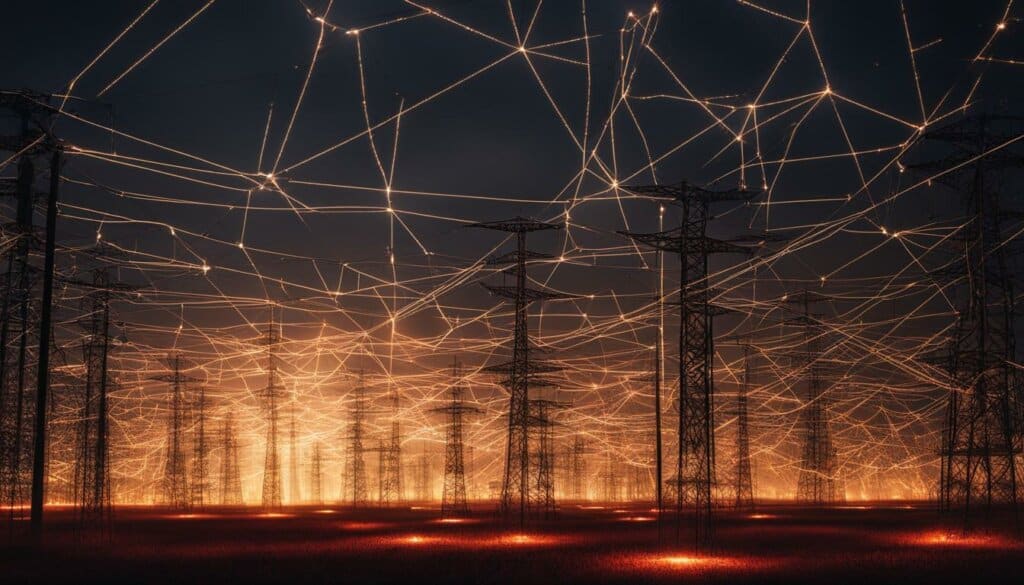
The findings from the GAO report emphasize the urgent need to address grid vulnerabilities and strengthen critical infrastructure cybersecurity. By implementing robust security measures and ensuring comprehensive standards, we can enhance the resilience and protection of the U.S. electric grid.
Securing the Energy Grid through Collaboration and Innovation
The National Institute of Standards and Technology (NIST) plays a vital role in prioritizing the cybersecurity of the smart grid, ensuring the resilience of energy delivery systems. NIST develops cybersecurity standards that guide the industry in implementing effective measures to protect the grid from cyber threats. These standards provide a framework for organizations to assess and improve their cybersecurity posture, enhancing the overall security of the energy grid. By adhering to NIST cybersecurity standards, utility companies can proactively address vulnerabilities and mitigate risks.
Another crucial aspect of securing the energy grid is information sharing. Collaboration among utility companies, vendors, universities, national laboratories, and service providers is essential in developing comprehensive cybersecurity measures. By sharing threat intelligence, best practices, and lessons learned, these stakeholders can collectively strengthen the security of the grid. Information sharing enables organizations to stay informed about emerging threats and adopt proactive security measures to safeguard critical infrastructure.
“Cybersecurity by design” is a fundamental principle for countering cyber threats in the energy grid. It involves integrating security measures into the design, development, and operation of grid systems and technologies. By prioritizing cybersecurity from the outset, organizations can identify and address vulnerabilities early on, reducing the risk of successful cyberattacks. This approach also allows for the seamless integration of new concepts and technologies with existing infrastructure, ensuring resilience and adaptability in the face of evolving threats.
Benefits of Cybersecurity by Design in the Energy Grid
Implementing cybersecurity by design principles in the energy grid offers several benefits. Firstly, it minimizes the potential impact of cyber threats by incorporating robust security measures into the design and architecture of grid systems. This proactive approach strengthens the overall security posture and reduces the likelihood of successful attacks. Secondly, cybersecurity by design enables organizations to adapt and respond effectively to emerging threats. By building agile systems with operational cyber-fusion capabilities, energy infrastructure operators can monitor, recognize, and respond to evolving cyber threats in real-time. This enhances the resilience and reliability of the energy grid, ensuring uninterrupted power supply.
In conclusion, securing the energy grid requires collaboration, innovation, and a proactive approach to cybersecurity. The National Institute of Standards and Technology provides critical guidance through its cybersecurity standards, enabling organizations to enhance the security of the grid. Information sharing among stakeholders fosters collective knowledge and strengthens defense against cyber threats. By integrating cybersecurity by design principles, organizations can build resilient grid systems that adapt to evolving threats. Protecting the energy grid is essential, safeguarding critical infrastructure and ensuring the reliability and availability of electricity for the nation.
| Benefits of Cybersecurity by Design in the Energy Grid |
|---|
| Minimizes the potential impact of cyber threats |
| Strengthens the overall security posture |
| Reduces the likelihood of successful attacks |
| Enables effective adaptation and response to emerging threats |
| Builds agile systems with operational cyber-fusion capabilities |
| Enhances the resilience and reliability of the energy grid |
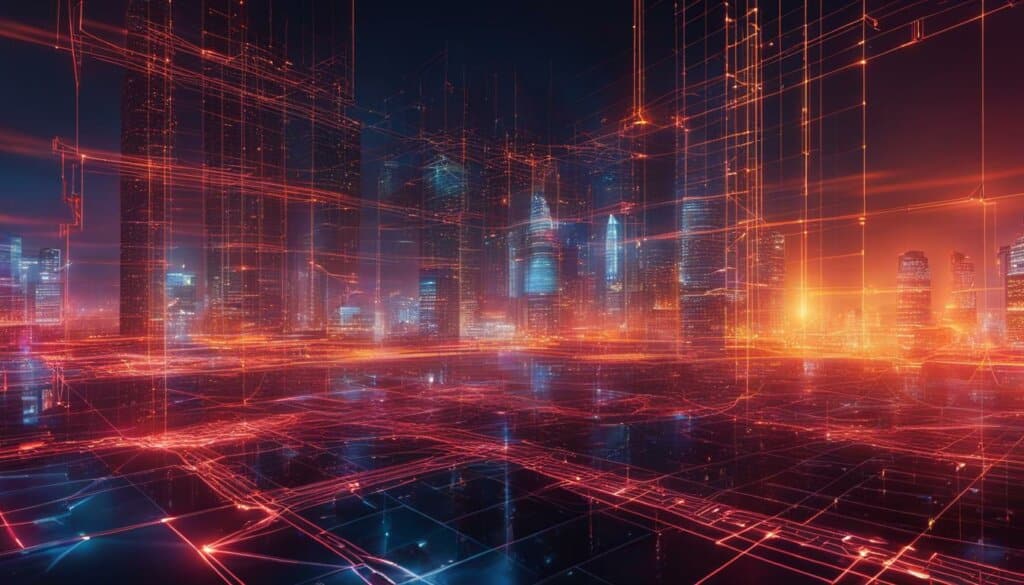
Detecting and Responding to Grid Cyber Attacks
The ever-evolving cyber threats to the energy grid require advanced technologies and strategies for effective attack detection and response. Machine learning, a branch of artificial intelligence, plays a crucial role in the detection of grid cyber attacks. By analyzing large volumes of data, machine learning algorithms can identify patterns and anomalies that indicate potential threats. These algorithms can continuously learn and adapt to new attack tactics, enhancing the grid’s resilience against cyber threats.
Incident response plans are vital in mitigating the impact of grid cyber attacks. Organizations must have well-defined protocols and procedures in place to promptly address and contain security incidents. This includes isolating compromised systems, restoring data and services, and conducting thorough investigations to determine the extent of the breach. Incident response teams should also collaborate with law enforcement agencies and share relevant information to aid in the identification and apprehension of threat actors.
“Secure communication networks are essential in preventing and mitigating cyber attacks on the grid. By encrypting data transmission and implementing robust authentication mechanisms, organizations can ensure that critical information remains secure and inaccessible to unauthorized individuals. This helps safeguard the integrity and confidentiality of grid operations, making it harder for threat actors to infiltrate and compromise the system.”
Anomaly detection systems can provide early warning signs of a potential cyber attack on the energy grid. By continuously monitoring network traffic and system behavior, these systems can identify deviations from normal patterns and alert security teams to investigate further. This proactive approach allows for timely detection and mitigation of threats, minimizing the potential impact on grid operations.
| Attack Detection Strategies | Benefits |
|---|---|
| Machine Learning | • Identifies patterns and anomalies • Adapts to new attack tactics • Enhances grid resilience |
| Incident Response Plans | • Prompts prompt containment of incidents • Ensures efficient restoration of services • Facilitates collaboration with law enforcement |
| Secure Communication Networks | • Protects critical information • Safeguards grid integrity and confidentiality |
| Anomaly Detection Systems | • Provides early warning signs of attacks • Enables proactive threat mitigation |
Detecting and responding to grid cyber attacks is an ongoing challenge that requires a combination of technological advancements, robust incident response capabilities, and proactive security measures. By leveraging machine learning, implementing incident response plans, securing communication networks, and deploying anomaly detection systems, organizations can enhance the security and resilience of the energy grid, mitigating the potential impact of cyber threats.
Challenges and Opportunities in Grid Cybersecurity
The evolving cyber threats in the energy sector pose significant challenges for grid cybersecurity. As the industrial internet of things (IoT) continues to expand, the attack surface for hackers widens, making it more challenging to protect critical infrastructure. Infrastructure operators face the complex task of securing interconnected systems while ensuring the uninterrupted delivery of electricity to consumers.
One of the main cybersecurity challenges in the energy grid is the integration of the industrial IoT. The increased connectivity of devices, sensors, and control systems introduces a multitude of entry points for potential cyberattacks. It requires robust security measures to protect against unauthorized access, data breaches, and system disruptions. Infrastructure operators need to implement security by design principles to build resilient and agile systems that can detect, monitor, and respond to emerging threats efficiently.
However, these challenges also present opportunities for innovation in grid cybersecurity. By adopting advanced technologies such as artificial intelligence and machine learning, energy infrastructure operators can enhance their threat detection capabilities. These technologies can analyze vast amounts of data, identify patterns, and detect anomalies that may indicate a cyberattack. Additionally, close collaboration between government agencies, industry partners, and international organizations can facilitate the sharing of best practices and the development of comprehensive cybersecurity strategies.
Key Challenges and Opportunities in Grid Cybersecurity:
- Evolving cyber threats in the energy sector
- Integration of the industrial IoT
- Cybersecurity challenges for infrastructure operators
As the energy grid becomes increasingly interconnected and reliant on digital systems, the importance of grid cybersecurity cannot be underestimated. It is crucial that infrastructure operators prioritize cybersecurity measures to protect critical infrastructure and ensure the reliable delivery of electricity to consumers.
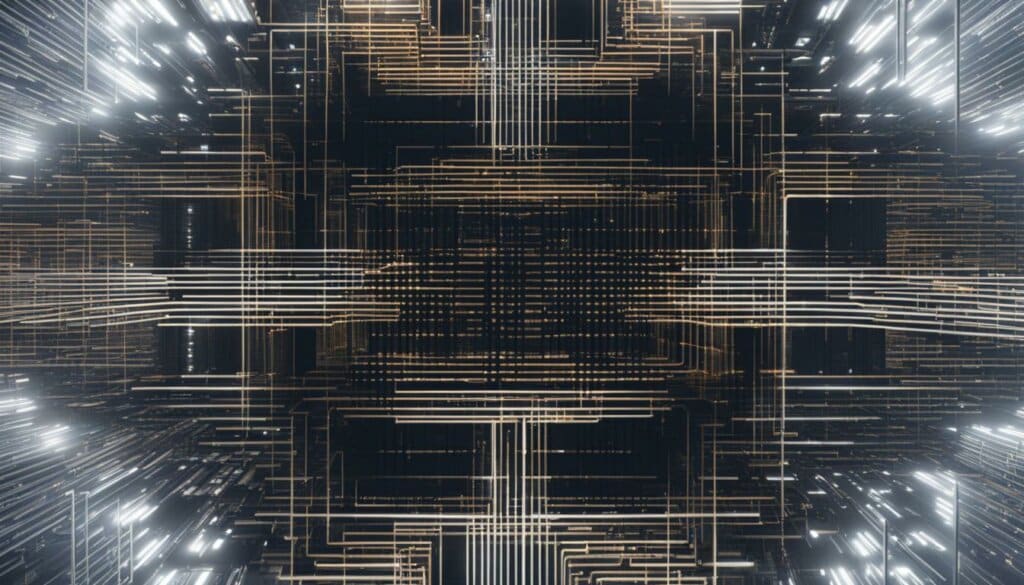
The Human Factor in Grid Cybersecurity
The human factor plays a vital role in ensuring the cybersecurity of the energy grid. While technological advancements and robust infrastructure are crucial, it is equally important to focus on cybersecurity awareness and training. Employees across the energy sector must be equipped with the knowledge and skills to recognize and mitigate cyber threats. By fostering a culture of cybersecurity, organizations can strengthen their defense against attacks and protect critical infrastructure.
Insider threats are a significant concern in grid cybersecurity. While external actors pose a risk, internal individuals with privileged access can exploit vulnerabilities and compromise the system. It is essential for organizations to implement stringent access controls, regularly monitor user activities, and conduct thorough background checks on employees. By addressing insider threats, organizations can enhance the overall security posture of the energy grid.
“The weakest link in the cybersecurity chain is the human element.”
User errors also contribute to the vulnerabilities in grid cybersecurity. Simple mistakes, such as clicking on malicious links or falling victim to phishing attempts, can have severe consequences. Ongoing training and education programs can help employees understand best practices for online security and how to identify potential threats. By empowering users to make informed decisions and practice good cyber hygiene, organizations can minimize the risk of human-related errors.
| Grid Cybersecurity Best Practices | Importance |
|---|---|
| Regular cybersecurity awareness training | To educate employees on potential threats and preventive measures |
| Implementing strong access controls | To mitigate insider threats and control user privileges |
| Conducting background checks on employees | To identify any potential risks during the hiring process |
| Establishing incident response protocols | To minimize the impact of cyber attacks and ensure a swift response |
| Regularly updating and patching systems | To address known vulnerabilities and strengthen security |
By prioritizing cybersecurity awareness, training, and addressing human-related risks, organizations can significantly enhance the resilience of the energy grid. The collaboration between technology, processes, and people is key to safeguarding critical infrastructure and ensuring the reliable delivery of electricity to communities.
International Collaboration for Grid Cybersecurity
The protection of the energy grid from cyber threats requires international collaboration, information sharing, and the adoption of best practices. Given the interconnected nature of the energy sector, cooperation between nations is crucial to enhance the resilience of critical infrastructure. By working together, we can effectively combat cyber threats and safeguard the energy grid for a sustainable and secure future.
International cybersecurity collaboration facilitates the sharing of knowledge, experiences, and threat intelligence across borders. Through collaborative efforts, industry leaders, government agencies, and international partners can exchange information on emerging cyber threats, vulnerabilities, and effective countermeasures. This collective knowledge helps enhance the effectiveness and efficiency of grid cybersecurity initiatives, enabling stakeholders to stay ahead of evolving threats.
The Electric Grid Cybersecurity Alliance brings together utility CEOs, CISOs, CIOs, and operational executives to develop industry-wide cybersecurity strategies. This collaborative approach fosters the exchange of best practices and encourages the implementation of robust cybersecurity measures throughout the energy sector.
By pooling resources, expertise, and technologies, international collaboration strengthens grid cybersecurity capabilities and promotes a coordinated response to cyber incidents. It encourages the development and adoption of standardized cybersecurity frameworks, ensuring consistency and alignment across national boundaries. Through these collaborative efforts, countries can collectively address the challenges posed by cyber threats and safeguard critical energy infrastructure.
“International collaboration is crucial in addressing the complex and evolving nature of grid cybersecurity threats. By sharing information, experiences, and best practices, we can collectively enhance the resilience of the energy grid and protect our critical infrastructure.”
International Cybersecurity Collaboration: Key Benefits
- Promotes information sharing on emerging cyber threats and vulnerabilities
- Encourages the adoption of best practices and standardized cybersecurity frameworks
- Strengthens grid cybersecurity capabilities through the pooling of resources and expertise
- Enhances the effectiveness and efficiency of grid cybersecurity initiatives
- Facilitates a coordinated response to cyber incidents, minimizing disruption and impact
Example of International Cybersecurity Collaboration Organizations:
| Organization | Mission |
|---|---|
| The Electric Grid Cybersecurity Alliance | To bring together utility CEOs, CISOs, CIOs, and operational executives to develop industry-wide cybersecurity strategies |
| International Society of Automation (ISA) | To advance the understanding and adoption of cybersecurity standards and best practices in industrial automation and control systems |
| North American Electric Reliability Corporation (NERC) | To ensure the reliability and security of the bulk power system in North America by developing and enforcing mandatory cybersecurity standards |
International collaboration is integral to the effective protection of the energy grid from cyber threats. By harnessing collective knowledge, resources, and expertise, we can strengthen grid cybersecurity capabilities and ensure the resilience of critical infrastructure. Through information sharing, best practice adoption, and standardized frameworks, we can stay one step ahead of evolving cyber threats and safeguard the energy grid for generations to come.
Conclusion
Cybersecurity in the energy sector is of utmost importance for protecting the grid and ensuring the resilience of critical infrastructure. The vulnerabilities in the U.S. electricity grid highlight the need for comprehensive risk management, threat detection, vulnerability assessment, and incident response. By prioritising grid cybersecurity, we can safeguard our energy infrastructure and secure our future.
Collaboration among government agencies, industry, and international partners is vital in addressing the growing cyber threats to the energy grid. It is essential to work together, share information, and implement best practices to enhance the protection of energy critical infrastructure from cyber attacks.
By recognising the significance of grid protection and investing in cybersecurity measures, we can mitigate the risks posed by evolving cyber threats. The importance of grid resilience cannot be understated, and it is our collective responsibility to ensure the security and reliability of the energy grid for the benefit of society as a whole.
FAQ
What are the key vulnerabilities in the U.S. electricity grid?
The grid distribution systems and their remote access capabilities pose significant vulnerabilities to cyberattacks.
Who are the main threat actors targeting the U.S. electricity grid?
Nation-states and criminal groups are the primary threat actors posing cyber threats to the U.S. critical infrastructure, including the electricity grid.
What are the federal efforts to address grid cybersecurity risks?
The Department of Energy (DOE) has plans to implement a national cybersecurity strategy, and the Federal Energy Regulatory Commission (FERC) has approved mandatory grid cybersecurity standards. However, there is a need for better assessment and addressing federal guidance.
Why is grid modernization urgently needed?
The aging infrastructure and increasing power demands make the grid susceptible to cascading failures and more vulnerable to cyberattacks. The Department of Energy (DOE) has launched the “Building a Better Grid” initiative to invest over $20 billion in federal funding for grid expansion and modernization.
How do cyber threats to the grid evolve?
Threat actors, including nation-states, criminal groups, and terrorists, continue to pose significant cyber threats to the U.S. critical infrastructure. The integration of hardware and software, networked sensors, and the industrial internet of things has expanded the attack surface for hackers.
What efforts have been made to address grid vulnerabilities?
Government agencies and industry recognize the vulnerabilities of the U.S. electric grid. The General Accounting Office (GAO) has highlighted these vulnerabilities, and the Federal Energy Regulatory Commission (FERC) has approved mandatory grid cybersecurity standards. However, there is a need for further alignment with federal guidance.
How is collaboration and innovation being utilized to secure the energy grid?
The National Institute of Standards and Technology (NIST) prioritizes the cybersecurity of the smart grid and promotes collaboration among utility companies, vendors, universities, and national laboratories. Cybersecurity by design is essential for countering threats in the energy grid.
How are grid cyber attacks detected and responded to?
Advanced technologies such as machine learning can aid in attack detection, and incident response plans need to be in place. Secure communication networks and anomaly detection systems play a crucial role in prevention and mitigation.
What are the challenges and opportunities in grid cybersecurity?
Grid cybersecurity faces challenges due to evolving threats, integration of the industrial internet of things, and increasing attack surfaces. However, there are opportunities to build agile systems and operational cyber-fusion to monitor, recognize, and respond to emerging threats.
How does the human factor impact grid cybersecurity?
Cybersecurity awareness training is crucial for employees to recognize and mitigate cyber threats. Insider threats and user errors can pose vulnerabilities. Ensuring a culture of cybersecurity and continual training is essential in reducing human-related risks.
How important is international collaboration for grid cybersecurity?
International collaboration is crucial for sharing information and best practices in grid cybersecurity. Organizations like The Electric Grid Cybersecurity Alliance bring utility executives together to develop industry-wide cybersecurity strategies.
Source Links
- https://www.gao.gov/blog/securing-u.s.-electricity-grid-cyberattacks
- https://www.forbes.com/sites/chuckbrooks/2023/02/15/3-alarming-threats-to-the-us-energy-grid–cyber-physical-and-existential-events/?sh=26671124101a
- https://www.ncbi.nlm.nih.gov/pmc/articles/PMC8473297/


